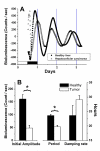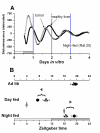Daily timed meals dissociate circadian rhythms in hepatoma and healthy host liver
- PMID: 16231323
- PMCID: PMC1464797
- DOI: 10.1002/ijc.21591
Daily timed meals dissociate circadian rhythms in hepatoma and healthy host liver
Abstract
Dividing cells, including human cancers, organize processes necessary for their duplication according to circadian time. Recent evidence has shown that disruption of central regulation of circadian rhythms can increase the rate at which a variety of cancers develop in rodents. To study circadian rhythms in liver tumors, we have chemically induced hepatocellular carcinoma in transgenic rats bearing a luciferase reporter gene attached to the promoter of a core circadian clock gene (Period 1). We explanted normal liver cells and hepatomas, placed them into short-term culture, and precisely measured their molecular clock function by recording light output. Results show that isolated hepatocellular carcinoma is capable of generating circadian rhythms in vitro. Temporally restricting food availability to either day or night altered the phase of the rhythms in both healthy and malignant tissue. However, the hepatomas were much less sensitive to this signal resulting in markedly different phase relationships between host and tumor tissue as a function of mealtime. These data support the conclusion that hepatoma is differentially sensitive to circadian timing signals, although it maintains the circadian organization of the nonmalignant cells from which it arose. Because circadian clocks are known to modulate the sensitivity of many therapeutic cytotoxic targets, controlling meal-timing might be used to increase the efficacy of treatment. Specifically, meal and treatment schedules could be designed that take advantage of coincident times of greatest tumor sensitivity and lowest sensitivity of host tissue to damage.
Figures



References
-
- Scheving LE, Tsai TH, Scheving LA. Chronobiology of the intestinal tract of the mouse. The American Journal of Anatomy. 1983;168(4):433–65. - PubMed
-
- Bjarnason GA, Jordan RC, Sothern RB. Circadian variation in the expression of cell-cycle proteins in human oral epithelium. http://www.ncbi.nlm.nih.gov/entrez/query.fcgi?cmd=Retrieve&db=PubMed&dop.... Am J Pathol. 1999;154(2):613–22. - PMC - PubMed
-
- Bjarnason GA, Jordan RC, Wood PA, Li Q, Lincoln DW, Sothern RB, Hrushesky WJ, Ben-David Y. Circadian expression of clock genes in human oral mucosa and skin: association with specific cell-cycle phases. http://www.ncbi.nlm.nih.gov/entrez/query.fcgi?cmd=Retrieve&db=PubMed&dop.... Am J Pathol. 2001;158(5):1793–801. - PMC - PubMed
-
- Haus E, Smolensky MH. Biologic rhythms in the immune system. http://www.ncbi.nlm.nih.gov/entrez/query.fcgi?cmd=Retrieve&db=PubMed&dop.... Chronobiol Int. 1999;16(5):581–622. - PubMed
Publication types
MeSH terms
Substances
Grants and funding
LinkOut - more resources
Full Text Sources
Medical

